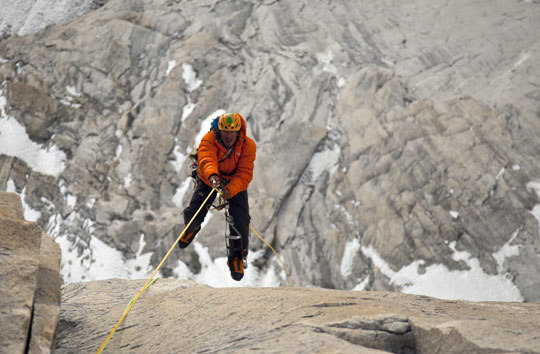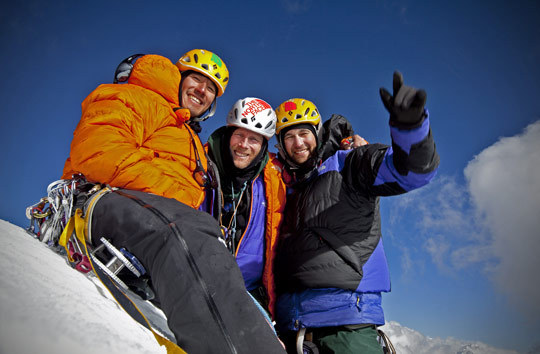
Anker, Chin and Ozturk’s recent route up the Shark’s Fin on the northwest face of Meru Central (6310m), Garhwal Himalaya. The trio reached the summit on October 2 after twelve days of climbing. Their ascent resolves thirty years of more than two dozen attempts by elite alpinists to climb this direct line on the Fin. [Photo] Jimmy Chin
American climbers Conrad Anker, Jimmy Chin and Renan Ozturk climbed Meru Central (6310m) via the Shark’s Fin in a twelve-day push. They summited on October 2 to become the first team to complete this highly sought-after objective. The Shark’s Fin has repelled many experienced alpinists, with attempts on this line numbering in the dozens. This was Anker’s third attempt to establish a route up the Fin, and the second attempt for both Chin and Ozturk. Over the years, the trio has accumulated thirty-plus days on this prow.
Several would-be ascents of the Shark’s Fin resulted in new routes on Meru Central. After an initial attempt on the Fin in spring of 2001, Valeri Babanov returned that autumn to establish Shangri La (ED 5.9/5.10 A1/A2 M5 75 degrees) to the right of the Shark’s Fin line in a solo first ascent of the mountain that earned him a Piolet d’Or.
A light-and-fast attempt on the Shark’s Fin was attempted by Anker, Doug Chabot and Bruce Miller in 2003. This team was turned away two-thirds of the way up the prow by deep, unconsolidated snow and a lack of proper gear for the upper wall. The following year the Japanese team of Hiroyoshi Manome, Yasushi Okada, Makoto Kuroda and Yasuhiro Hanatani set a new highpoint on the Fin at 6100m, but descended after Hanatani broke both legs.
It was initially reported that Czechs Marek Holecek and Jan Kreisinger completed the second ascent of Meru Central in November 2006, but it was quickly discovered that the same Japanese team that attempted the Shark’s Fin in 2004 had already achieved the second ascent of the peak by a variation of Babanov’s route. A few days after the Japanese summited, the Czechs ticked the third ascent after aborting an attempt on the Shark’s Fin and climbing instead to the right of the direct line, in yet another variation on Babanov’s route.
Anker made his second attempt on the prow with Chin and Ozturk in 2008. The team was delayed on the climb for several days during a storm that dropped six feet of snow and, according to Chin, shut down the entire Himalaya. When the storm relented, they progressed beyond the highpoint of Anker’s 2003 attempt. However, the team had severely rationed their ten-day supply of food during the storm; on their nineteenth day on the climb the team stopped about 150 meters below the summit. In a video dispatch posted after the team’s return, Chin said, “Maybe this wasn’t meant to be climbed … I’m not coming back.”

Renan Ozturk at the final camp before the summit push on the Shark’s Fin. Ozturk and his partners have spent more than thirty days on the climb over the years. [Photo] Jimmy Chin
The trio were happy to give beta on their 2008 route to other teams aspiring to be the first to climb Meru via the Shark’s fin. The following year the Slovenians Silvo Karo, Marko Lukic and Andrej Grmovsek attempted the same route in alpine style, hoping that a light-and-fast attempt over six days would circumvent some of the difficulties that the American team encountered in 2008. The unsettled weather prevented the Slovenians from acclimatizing as planned on other routes first; they decided to make the attempt nonetheless. After completing the two-day approach, a 700m snow slope and the rock ramp that leads to the headwall, the team turned around, citing a lack of proper gear, poor acclimatization and their alpine-style approach as mistakes for an attempt on the Shark’s Fin.
Of Silvo Karo’s team’s attempt, Chin said, “We were all hoping he would get it done. But I thought, if he doesn’t get it, maybe I’ll go back and try it. And when he didn’t get it, Conrad and I started talking a little bit about it again. It’s such an iconic, legendary route. Nobody’s been able to do it. We got so close in 2008; and having that knowledge of the route, knowing all the little things we would’ve done differently, it’s hard not to go back and throw ourselves at it again.”
This September Anker, Chin and Ozturk pushed through the bottom part of the route in a speedy six days. After climbing, hauling and jugging to the base of the overhanging Indian Ocean Wall, the team climbed steep aid sections with difficulties up to A4. These sections gave way to the Crystal Pitch, an overhanging and extremely exposed prow that they aided. A final section of mixed and aid climbing brought the team to the summit of Meru on October 2.
Anker and Chin were both quick to cite the good weather as a major factor in their success. Though temperatures rarely rose above minus twenty during the day, the clear skies allowed the team to cover a distance in a single day that took them six days during their last attempt. According to Chin, a unique challenge of this route is the range of equipment it requires. The team brought equipment for technical and alpine ice and rock in addition to a big-wall kit, rather than attempting the route alpine-style like the many teams before them.
“Tons of teams have tried the route alpine style. But you just can’t. You have to go aid climbing. It’s modern A4 up there,” Chin said. “Hauling a big-wall kit through the lower alpine route complicates things right off the deck, which is part of what makes this route so logistically challenging.”

Jimmy Chin jugs the upper wall of Shark’s Fin. “Tons of teams have tried the route in alpine style. But you just can’t. You have to go aid climbing. It’s modern A4 up there,” Chin said. [Photo] Jimmy Chin collection
Cumulatively, the three climbers have spent more than thirty days on the Shark’s Fin. Their multiple attempts through bad weather, severely rationed supplies and a broken portaledge make this final ascent “one of the most meaningful we have ever experienced,” Ozturk said. Their shared experience on the route in 2008 was an crucial factor this year; Chin said that going back with the same team was important to all of them, especially after Ozturk’s ski accident in March of this year, which left him with severe cranial and spinal injuries.
“For Renan to come back and do this route was a really big deal,” Chin said. “We could’ve brought someone else on, but it was important for us to have him.” Anker agreed; he said they could have reduced their time on the climb by three days if they had climbed in a two-man team, but the experience of returning with the same trio was an important aspect of the expedition.
For Anker, this third attempt on the Shark’s Fin was also a remembrance. “For me it was a tribute to Mugs [Stump]. We had talked about the Shark’s Fin, and I had that unfinished business going back to a partner.” Anker also praised his wife, Jennifer, and their sons for their support of the trip. “I think for the boys, the risk associated with this trip was a little bit different than it was for Jenny. It was also during the post-monsoon season, and twelve years since Alex passed away. The experience was pretty stressful for her.” Alex Lowe, Anker’s climbing partner and Jenny Lowe-Anker’s first husband, was killed in a post-monsoon-season avalanche on Shisha Pangma in October of 1999.
The three climbers are eager to see others try their route. When asked if he had advice for climbers attempting the second ascent, Chin laughed, “They should call me.” He and Anker agree that now that the route is in place, the second ascent could happen soon–but perhaps only with the right conditions. “I can’t stress enough the importance that the weather played during our trip,” Anker said. “We got incredibly lucky.”
Read through our NewsWire archives to dig deeper into the Shark’s Fin history:
November 16, 2006 NewsWire – Meru’s Shark’s Fin Remains Unclimbed
November 20, 2006 NewsWire – Japanese Climb Meru Before Czechs

The trio on the sunny summit of Meru on October 2. “We were incredibly lucky with the weather,” Anker said. The climbers savored their success by drinking coffee at the summit before starting the two-day rappel to the base. [Photo] Jimmy Chin